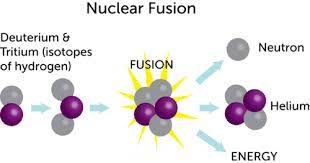Context:
Scientists in the United States have, for the first time, achieved a net gain in energy from a nuclear fusion reaction, seen as a big step forward in the decades-old endeavour to master a technology that is considered the most dependable source of energy in future.
Relevance:
Prelims, GS-III: Science and Technology (Nuclear Technology)
Dimensions of the Article:
- Nuclear Fusion
- Advantages of Nuclear Fusion
- About the Fusion Ignition experiment in the U.S.
About Net Energy gain:
- Researchers at the Lawrence Livermore National Laboratory in California for the first time produced more energy in a fusion reaction than was used to ignite it, something called net energy gain.
- The achievement will pave the way for advancements in national defense and the future of clean power.
- This is a landmark achievement for the researchers and staff at the National Ignition Facility who have dedicated their careers to seeing fusion ignition become a reality, and this milestone will undoubtedly spark even more discovery
Nuclear Fusion

- Nuclear Fusion is defined as the combining of two lighter nuclei into a heavier one.
- Such nuclear fusion reactions are the source of energy in the Sun and other stars.
- It takes considerable energy to force the nuclei to fuse. The conditions needed for this process are extreme – millions of degrees of temperature and millions of pascals of pressure.
- The hydrogen bomb is based on a thermonuclear fusion reaction. However, a nuclear bomb based on the fission of uranium or plutonium is placed at the core of the hydrogen bomb to provide initial energy.
Advantages of Nuclear Fusion
- Fusing atoms together in a controlled way releases nearly four million times more energy than a chemical reaction such as the burning of coal, oil or gas and four times as much as nuclear fission reactions (at equal mass).
- Fusion has the potential to provide the kind of baseload energy needed to provide electricity to the cities and the industries.
- Fusion fuels are widely available and nearly inexhaustible. Deuterium can be distilled from all forms of water, while tritium will be produced during the fusion reaction as fusion neutrons interact with lithium.
- Fusion doesn’t emit harmful toxins like carbon dioxide or other greenhouse gases into the atmosphere. Its major by-product is helium: an inert, non-toxic gas.
- Nuclear fusion reactors produce no high activity, long-lived nuclear waste.
- Fusion doesn’t employ fissile materials like uranium and plutonium (Radioactive tritium is neither a fissile nor a fissionable material).
- It is difficult enough to reach and maintain the precise conditions necessary for fusion—if any disturbance occurs, the plasma cools within seconds and the reaction stops.
About the Nuclear Fusion Ignition experiment in the U.S.
- The U.S. researchers applied laser energy on fuel pellets to heat and pressurise them at conditions similar to that at the centre of our Sun which triggered the fusion reactions.
- These reactions released positively charged particles called alpha particles (helium), which in turn heated the surrounding plasma.
- The heated plasma also released alpha particles and a self-sustaining reaction called ignition took place.
- Ignition helps amplify the energy output from the nuclear fusion reaction and this could help provide clean energy for the future.
- Reproducing the conditions at the centre of the Sun will allow studying:
- Plasma, the state of matter that has never been created in the lab before.
- Gain insights into quantum states of matter.
- Conditions closer and closer to the beginning of the Big Bang.
-Source: Indian Express





